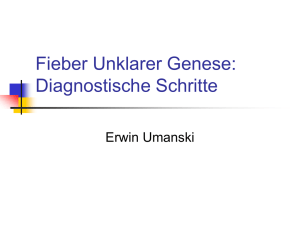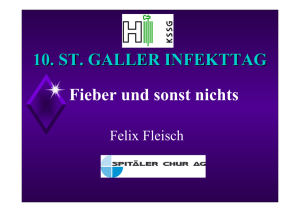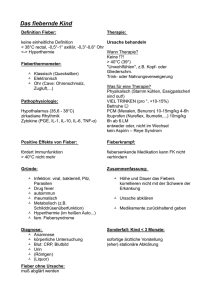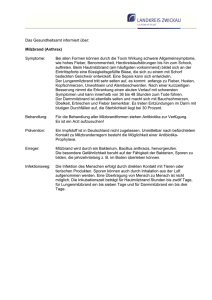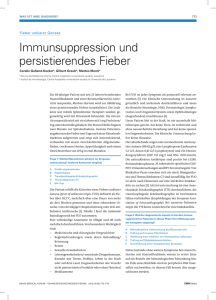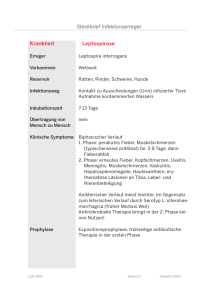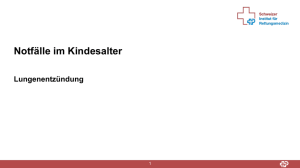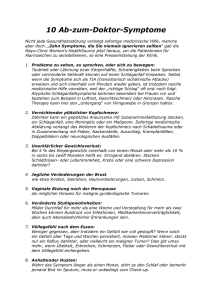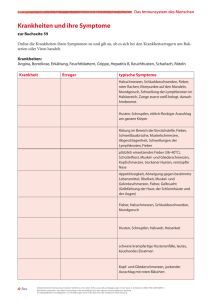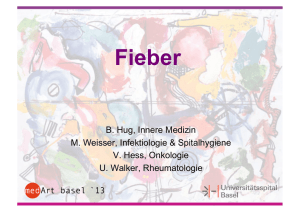Der febrile Patient - Infektiologie
Werbung
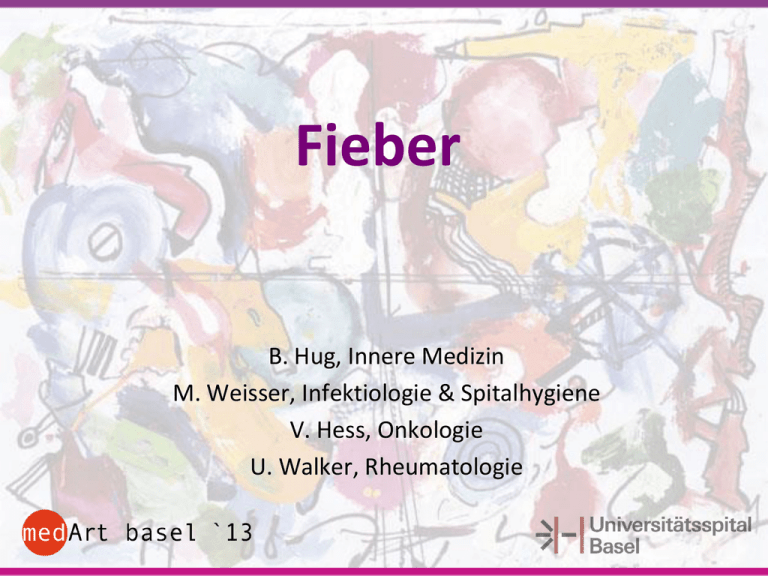
Fieber B. Hug, Innere Medizin M. Weisser, Infektiologie & Spitalhygiene V. Hess, Onkologie U. Walker, Rheumatologie Fieber: die infektiologische Perspektive • Fever of Unknown Origin • Fieber beim Multimorbiden Patienten • Fieber und Immunsuppressiva (u.a. EBV) FUO: Definition 1961 T> 38.3°C an mehreren Zeitpunkten > 3 Wochen ohne eine Diagnose trotz 1 Woche stationärer Abklärung Petersdorf RG, Medicine 1961;40:1-30 1992 T > 38.3°C an mehreren Zeitpunkten > 3 Wochen ohne eine Diagnose trotz 1 Woche Abklärung (stationär oder ambulant) Petersdorf RG, Arch Intern Med 1992; 152:21-22 1991 4 Gruppen: klassisches FUO nosokomiales FUO neutropenisches FUO (Fieber in Neutropenie) HIV-assoziertes FUO Durack DT, Curr Clin Top Infect Dis 1991;11:35-51. Horowitz HW, NEJM 2013; 368:3:197-8 Sizilien 1991-2002 91 Patienten mit FUO Peking Türkei 2004-2010 2003-2004 997 Patienten mit FUO 154 Patienten mit FUO • 32% Infektion • 48% Infektion - Tuberkulose 45% • 34% Infektion - Tuberkulose 40% • 14% Malignom • 8% Malignom • 14% Malignom • 12% Entzündl. KH • 17% Entzündl. KH • 31% Entzündl. KH - M. Still 32% - Vaskulitis 24% - M. Still 45% - Vaskulitis 30% • 10% Anderes • 7% Anderes • 5% Anderes • 32% keine Ursache • 20% keine Ursache • 16% keine Ursache Wie können die 200 DDs des FUOs kosteneffizient abgeklärt werden? - Blutsenkung (BSR) - C-reactive protein (CRP) - Differential-Blutbild - Kreatinin und Elektrolyte - Eiweisselektrophorese - Leberwerte inkl. LDH - CK, ANA, Rheumafaktoren - Urinstatus - ≥3 Blutkulturen, Urinkultur - Rx Thorax - Ultraschall Abdomen (oder CT) - Mantoux potentially diagnostic clues localizing signs and symptoms Test abnormalities I. PDCs present I. PDCs absent or misleading Bleeker-Rovers CP, Medicine 2007;86:26–38 potentially diagnostic clues Limitierte DD fokussierte Abklärung * * Knochenmark Temporalarterienbiopsie (> 55J) Fundoskopie Thorako-abdominale Computertomographie Bleeker-Rovers CP, Medicine 2007;86:26–38 Diagnosen 73 Patienten (40 Universitätsspital, 33 Regionalspital) Infektionen Keine Diagnose (2) (1) (1) (1) (2) (1) (4) 16% 7% Neoplasie 51% 16 Spontane Besserung 15 pers. Fieber 5 Ansprechen auf NSAR 1 Todesfall Respiratorischer Infekt Divertikulitis Pyelonephritis Abdomineller Abszess Osteomyelitis Tonsillitis chronische Yersiniose Entzündliche Erkrankung 22% Anderes NHL (3) Mamma-CA (1) Adeno-Ca CUP (1) Grossgefässvaskulitis Polymalgia rheumatica Purpura Schönlein-Henoch Mikroskopische Polyangitis Psoriasis-Arthritis Adulter M Still SLE Kryoglobulinämie (2) (3) (1) (1) (1) (3) (4) (1) Drug fever (2), Hypertrigliceridämie (1) Prädiktoren einer Diagnose Diagnostischer Wert verschiedener Untersuchungen (n=73) ‚Potentially diagnostic clues‘ hilfreich: in 80% nicht diagnostisch Gewichtsverlust, Muskelschwäche, Hautveränderungen, Atemnot, Brustschmerz, Bauchschmerz, Morgensteifigkeit Bildgebung Kein Diagnostischer Wert ‚unfokussierter‘ Untersuchungen: zB. > 3 BK, > 1 Urinkultur, ‚Serologie-Blöcke‘ Endokrinologische Tests, CT NNH, Kolonoskopie u.a. 18F-Fluorodeoxyglucose Positron Emission Tomography in Elderly Patients with an Elevated ESR of Unknown Origin Lensen K-JDF et al. PLoS ONE; 2013 8(3): e58917 58 Patienten > 50 J mit BSR und unspez. Symptomen (ohne Dg nach standardisiertem Workup) 40 22 1 45% falsch positive PET/CT Aetiologie Fieber Patientenbeispiel Endokarditis Meningitis Pneumonie EBV ? (Immunsuppression?) Tumorfieber Medikamente ‚OLD‘ FUO ‚NEW‘ FUO T > 38.3°C > 3 weeks > 1 week of investigation - Patients on ICU Traumatic brain injury Mechanically ventilated Catheter (urethral, venous, arterial) Recent surgery Multiple medications Broad-spectrum antibiotics EBV PCR 10‘086 Kopien/ml EBV EBNA und VCA IgG positiv A unspezifische Reaktivierung B hinweisend auf eine EBV-assoziierte Neoplasie C EBV-assoziierte Hämophagozytose D Fehlbestimmung im Labor E EBV-Primoinfektion (infektiöse Mononukleose) EBV Infektion Primo-Infektion Asymptomatisch Mononukleose Persistenz Chronische Infektion Reaktivierung Young LS and Rickinson AB, Nat Rev Cancer 2004 Persistenz - Immunsuppression - Malaria - Co-Faktoren? Malignome - Burkitt-Lymphom - T-Zell-Lymphom - M. Hodgkin - PTLD - Nasopharyngeal-CA Lympoproliferative disorders - X-linked lympho-proliferative disorder (XLP) - Hemophagocytic Lymphohistiocytosis (HLH) - Lymphomatoid granulomatosis - PTLD Positive EBV-PCR im Blut Dynamik der Virämie? Hinweise für Malignom/ monoklonale Expansion Hopwood PA, Transplantation 2002 Fieber bei Immunsupprimierten Patienten Therapien Immunsuppressiva Transplantation Aplasie Chemotherapie Radiotherapie Grundkrankheit Malignom Niereninsuffizienz COPD Alter Erkrankungen des Immunsystems Zelluläre Immundefizienz Immundefekte HIV-Infektion Splenektomie Komplement Mangel zelluläre Immundefizienz Steroide Proliferationshemmer (MMF, Aza) FasL CTL IL-2 NK Anti-TNFα IFNγ NK Neutro Granzyme B Perforin Th APC IL-2 Th Th Th MØ Th TNFα etc. IL-5 Neutro Eo M MBP CNI (CyA, Tac) mTOR-I (Sir, Eve) T-Zell Depletion (ATG, CD52, Cyclo) IFNγ IL-4 IL-5 IL-13 B-cell anti-HLA Ab C-activation ADCC B-Zell Depletion (Rituximab, Bortezomib, Cyclo) Abklärung/DD bei Fieber bei zellulärer IS INFEKTE • Barrieren zB Katheter/Port-à-cath ? Mukositis ? Lunge: Ziliäre Clearance?/Stenosen? postoperative Infektionen • Opportunistische Infekte Lymphopenie? CD4-Zellzahl? Hypogammaglobulinämie? • Umfeld: Grippe? Varicellen? NICHT-Infektiös Medikamente ? Grundkrankheit ? Literatur Horowitz HW: Fever of unknown origin or fever of too many origins? NEJM 2013; 368:3:197-8 Bleeker-Rovers CP: A prospective multicenter study on fever of unknown origin: the yield of a structured diagnostic protocol. Medicine 2007;86:26–38 Lensen K-JDF et al. 18F-Fluorodeoxyglucose Positron Emission Tomography in Elderly Patients with an Elevated Erythrocyte Sedimentation Rate of Unknown Origin. PLoS ONE; 2013 8(3): e58917 Young LS and Rickinson AB, Epstein-Barr virus: 40 years on. Nat Rev Cancer 2004; Oct;4(10):757-68. Hopwood PA, Persistent Epstein-Barr virus infection: unrestricted latent and lytic viral gene expression in healthy immunosuppressed transplant recipients. Transplantation 2002, Jul 27;74(2):194-202.

